Monday, December 29, 2008
Entrelac obsession
Friday, December 26, 2008
2x1 entrelac endless rectangle
You can knit a 2x1 entrelac rectangle as an endless spiral, stopping at 2, 8, 18, 32, etc. (Two times a square number.)
Monday, December 22, 2008
endless entrelac spiral
Better than the previous one. Start in the middle, then stop at 1, 4, 9, 16, 25, 36, etc. entrelac modules to form as large a square as you like.
Entrelac square as large as you want
Shows a method of working an entrelac square from the center out, which can be extended as far as you want.
Saturday, December 20, 2008
Entrelac Star
Entrelac Star
Copyright (c) 2008 Jay F. Petersen, all rights reserved.Unit 1:
Cast on 12 (n+1) stitches. Row 1: (Right side) *YO, RT, K2 ([n-7]/2), K2tog, rep from *. Row 2: Lay contrasting piece of yarn from back to front over working yarn, purl to end of row. Rows 3, 5, ..., 21 (2n-1): Repeat row 1. Rows 4, 6, ..., 20 (2n-2): Repeat row 2. Sanity check: there are 11 (n) lace eyelet holes going up the center of the unit. There are 10 (n-1) loops being held by the contrasting-color yarn. Leave the last row on the right needle.Units 2-4:
Place loops held by contrasting yarn onto left needle, from previous unit's left edge, starting from the bottom edge of the unit to top. (These loops are worked into the current unit's first row of stitches.) Remove contrasting yarn, and use it while knitting this unit. Row 1: (Right side) *YO, RT, K3 ([n-7]/2 +1), rep from *. Work rows 2-21 (2n-1) as for unit 1. Leave the last row on the right needle.Unit 5:
Unpick the cast-on and place the freed-up loops on the left needle, so that the right side of the first unit is facing you. There should be 11 (n) loops on the needle. Then place loops held by contrasting yarn on the left needle. There should now be 21 (2n-1) loops on the left needle. Row 1: YO, RT, K3 ([n-7]/2 +1), YO, RT, K2, SSK, turn. Row 2: Purl. Row 3: YO, RT, K2 ([n-7]/2), K2tog, YO, RT, K2 ([n-7]/2), Sl2K1PSSO, Rows 4, 6, ... 20 (2n-2): Repeat row 2. Rows 5, 7... 21 (2n-1): Repeat row 3. Leave the last row on the right needle.Finishing:
Crochet *chain 1, single-crochet in a stitch or loop, repeat from * in each loop or stitch around the star. When you get to the inner corners, gather three loops/stitches together into one sc. Finish with a slip stitch into the first single crochet.Friday, December 19, 2008
Entrelac Star with crocheted edging
I decided to finish this off with a crocheted edge: sc, ch1, in each stitch around the piece except, when I remembered to, I worked 3 loops together on the inside corners.
Entrelac star
 Entrelac star, originally uploaded by fuzzyjay.
Entrelac star, originally uploaded by fuzzyjay.Honestly, I finished this star before I realized how Christmasy it is. I was just trying out a new entrelac idea, really!
Wednesday, December 17, 2008
One-piece entrelac cube and Helen
I have achieved minimalism! One zig-zag (or stair-step, really) piece of knitting that is joined to itself in 3 different ways:
1. Entrelac joins (pick up stitches from side edge, join side edge to live stitches.)
2. Sliding-loop join from Rick Mondragon.
3. Grafting.
So, you can knit a cube with only one piece and with no seams… well, no sewn seams. Grafting is sewing, I guess, but it’s pretty flexible.
Monday, December 15, 2008
Entrelac cube variation 4
Video of the cube variation 4.
Minimal, perhaps. Two segments. First I knit a zigzag in lighter yarn, attaching the zigzag to itself as I went. This formed half of the cube: 3/4 of 3 faces and 1/4 of 3 other faces: (3 * 3/4 face) + (3 * 1/4 face) = 3 faces, or half of a cube (6 faces). Then I knit a zigzag in darker yarn, attaching the darker zigzag to the lighter colored zigzag and to itself as I went. At the very end, I had to graft together half of one edge of the cube.
Entrelac cube variation 4
 Entrelac cube variation 4, originally uploaded by fuzzyjay.
Minimal knitted entrelac cube? Only two pieces, both of which join to themselves through the regular entrelac means (by picking up stitches from previously-knit side edges and by knitting new side edges together with live stitches held in reserve), and with Rick Mondragon's sliding-loop technique.
Entrelac cube variation 4, originally uploaded by fuzzyjay.
Minimal knitted entrelac cube? Only two pieces, both of which join to themselves through the regular entrelac means (by picking up stitches from previously-knit side edges and by knitting new side edges together with live stitches held in reserve), and with Rick Mondragon's sliding-loop technique.
Wednesday, December 10, 2008
Self-joining motif entrelac cube
So I’ve been experimenting with entrelac cubes that feature motifs that are not square, but are still in the spirit of entrelac. The lighter-colored patches of this cube are in the shape of zig-zags, but each zig-zag is attached to itself along some of its edges. It makes a nice symmetry on the faces of the cube.
Monday, December 08, 2008
Entrelac cube variation 3
Cut 2 squares out of opposite corners of every face of a cube. Another of the entrelac knitted cube variations.
Entrelac cube variation
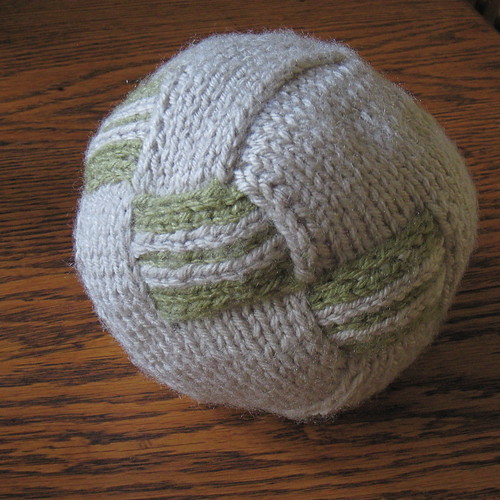 Entrelac cube variation, originally uploaded by fuzzyjay.
Entrelac cube variation, originally uploaded by fuzzyjay.Knitted with "Vanna's Choice" acrylic yarn. I think I'll do the next one in wool. I'm going to throw this in the washing machine and dryer and see if it evens out the shape. Right now, it's a little under-stuffed and lumpish.
entrelac cube variation
Take a six-square entrelac cube and cut out a square out of the corner of each of the original squares. This is one way to do it. I have knitted an example of this one.
Sunday, November 30, 2008
Mosaic pattern diagram
Mosaic knitting patterns that can be knitted from four directions can also be enlarged to 3x size. Here you see that you can have 16 copies of the original placed around the enlarged and color-reversed copy.
Thursday, November 20, 2008
yarnover on ravelry
Using the font I created on FontStruct. Writers of western European languages will find in this font most of the characters they need to write stuff in mosaic knitting. There are 189 different characters, most of which will probably never see the light of day as knitting!
Wednesday, November 19, 2008
Mosaic knitting alphabet font
Tuesday, November 18, 2008
Minimal continous cable.
 minimal continuous cables, originally uploaded by fuzzyjay.
minimal continuous cables, originally uploaded by fuzzyjay.This is one configuration of the smallest possible thing you can knit with entrelac where the cables appear to be continuous loops. The starts and ends of the cables are hidden under the cable crossings. The picture is my attempt to show a 3-d object as a diagram. The four squares in the center (marked 1-4) are the only ones that are actually knit. The others just serve to show how the 4 are connected on their other sides. When I work this up as a diagram in a computer program I will make that more obvious. There have to be four squares, because there must be one cable crossing to hide the start and end of the cables. But it is possible (I think) to make the four squares form a double-thick rectangle where there is only one continuous loop (this one has two.) I'm going to knit this up tomorrow. It should go quickly. What this could be used for, I dunno. A pillow?
Thursday, November 13, 2008
complicated entrelac cable
This knotty thing is theoretically knit-able and it would be possible to knit it in the round, which freaks me out to think about, and there is also a way to decrease in the less dense parts, so I guess it could be a bulky hat-thing.
I don't know, I was obsessed with figuring this out, and now I'm not so sure I want to knit it.
Wednesday, November 12, 2008
Apart and together
Apart and together, originally uploaded by fuzzyjay.
I knitted the baby shape, then the Menger Sponge, before it dawned on me that they are complementary shapes. Here's how they fit together. The baby shape is over stuffed, so it's a tight fit. The entrelac squares are knit the same on each one though, 7 stitches and 14-16 rows.
Sunday, November 02, 2008
Entrelac Menger Sponge (Cube)
 Entrelac Menger Sponge (Cube), originally uploaded by fuzzyjay.
Entrelac Menger Sponge (Cube), originally uploaded by fuzzyjay.Well, it's finally done. Seventy-two squares, knitted together as you go, no seams and only one length of yarn. Only one edge was grafted together. Every other edge of each square is either attached with decreases to another square's live stitches held in reserve, or picked up from the side edge of a previous square.
Wednesday, October 29, 2008
Entrelac Menger sponge version 2
This replaces my earlier attempt which could not be knitted with the constraints I've been working with (continuous piece of yarn and only one grafted edge). Alas, it's less symmetrical.
Monday, October 27, 2008
entrelac menger sponge
The torus wasn't complicated enough! This is a diagram of the first iteration of the Menger Sponge modeled in entrelac. Of course, the usual constraints apply to the knitting: one continuous piece of yarn, no seams except one grafted edge at the very end. Lots of provisional cast-ons.
Wednesday, October 22, 2008
Monday, October 13, 2008
Leafy branch
An experiment in adding compound leaves together to form a larger branch. This in turn could be a branch off a bigger branch.
Thursday, October 09, 2008
entrelac at a higher resolution2a
 entrelac at a higher resolution2a, originally uploaded by fuzzyjay.
entrelac at a higher resolution2a, originally uploaded by fuzzyjay.This is a more detailed diagram than the other one.
Tuesday, October 07, 2008
Finished Fiber Object
Friday, September 19, 2008
The bloom is off the bamboo
I was interested in bamboo as a fiber until I realized it’s just rayon.
I guess as a source of cellulose, bamboo is as good or better than others. Wood pulp is better used as paper, I suppose. But I was feeling all sexy about the fiber. Same with “soy silk”… you can make rayon out of any source of cellulose. Hey, wouldn’t it be nice if you could make it from animal products? Then you could have a “pork silk” purse made out of a sow’s ear.
Thursday, September 18, 2008
Wednesday, September 17, 2008
Entrelac cube update
Wednesday, September 10, 2008
Tuesday, September 09, 2008
Monday, September 08, 2008
SEO
Thursday, September 04, 2008
12-square entrelac cube with cables (garter stitch)
Tuesday, September 02, 2008
Saturday, August 30, 2008
Friday, August 29, 2008
Plan B for world entrelac domination
 |
| From Knitting Diag... |
Thursday, August 28, 2008
Wednesday, August 27, 2008
30-square entrelac cube starting from an edge
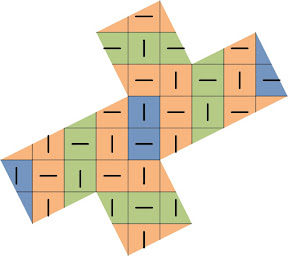 This is a model of a cube where the entrelac squares lie askew of the cube's edges. I have colored it in such a way that you could knit it with an interesting pattern. The knitting starts at the center and goes outward: 2 blue squares, then a ring of 8 orange squares, then a ring of 10 green squares, 8 orange squares and 2 blue squares (2-8-10-8-2). Each "ring" can be knitted with a single length of yarn.
The darker lines on the squares show the grain of the knitting.
Alas, it turns out that this is impossible to knit with the constraints I have been using for 3-d entrelac, that is, only one "seam" at the very end (where you have to graft the top of a square to a previously knitted square's side).
After thinking about this some more, I realize that this cube could be knitted with two pieces of yarn, knitting half the squares with one and half with the other. Knitting with 2 pieces of yarn avoids the problem mentioned above, and enables knitting this with only one of the grafted seams.
This is a model of a cube where the entrelac squares lie askew of the cube's edges. I have colored it in such a way that you could knit it with an interesting pattern. The knitting starts at the center and goes outward: 2 blue squares, then a ring of 8 orange squares, then a ring of 10 green squares, 8 orange squares and 2 blue squares (2-8-10-8-2). Each "ring" can be knitted with a single length of yarn.
The darker lines on the squares show the grain of the knitting.
Alas, it turns out that this is impossible to knit with the constraints I have been using for 3-d entrelac, that is, only one "seam" at the very end (where you have to graft the top of a square to a previously knitted square's side).
After thinking about this some more, I realize that this cube could be knitted with two pieces of yarn, knitting half the squares with one and half with the other. Knitting with 2 pieces of yarn avoids the problem mentioned above, and enables knitting this with only one of the grafted seams.
monster entrelac plan
OK, here I got a little crazy. This is the diagram for a 3-D entrelac shape I knitted for my first nephew. It knits up to be the shape of a cube surrounded by six other cubes. That shape has 5 time 6 equals 30 faces. Each face is made up of 4 half-squares, which gives a total of 60 squares.
It would definitely make more sense with a picture of the finished result. I'll work on that.
Tuesday, August 26, 2008
Another way to knit a cube in entrelac.

- Knit the 1st square. End on a wrong-side row. Do not break yarn.
- Cast on (or knit onto scrap yarn stitches cast onto the left needle) and knit the 2nd square. Attach the left side of the 2nd square to the top of the 1st square as you go. End on a right-side row.
- Pick up stitches on the left side of the 1st square (from the top down) and knit the 3rd square, attaching the right side to the top of the 2nd square as you go. End on a right-side row.
- Pick up stitches on the left side of the 3rd square (from the top down) and knit the 4th square, attaching the left side to the bottom of the 1st square as you go. End on a right-side row.
- Pick up stitches on the right side of the 1st square (from the bottom up) and knit the 5th square, attaching the left side to the bottom of the 2nd square and the right side to the top of the 4th square as you go. End on a right-side row.
- Pick up stitches on the right side of the 2nd square (from the bottom up) and knit the 6th square, attaching the left side to the top of the 3rd square and the right side to the top of the 5th square as you go. End on a wrong side row, leave a long tail of yarn. Stuff the cube if you like. Graft the top of the 6th square to the right side of the 4th square.
How to knit a cube in entrelac from corner to corner
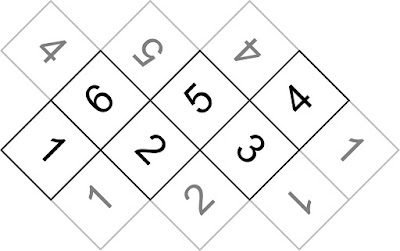 Explanation:
Explanation:
- Knit the 1st square. End on a wrong-side row.
- Pick up stitches on the right side of the 1st square (from the top down) and knit the 2nd square. End on a wrong-side row.
- Pick up stitches on the right side of the 2nd square (from the top down) and knit the 3rd square. Attach the right side of the 3rd square to the bottom of the 1st square as you go. End on a wrong-side row.
- Pick up stitches on the left side of the 1st square (from the top down) and knit the 4th square. Attach the left side of the 4th square to the top of the 3rd square as you go. End on a right-side row.
- Pick up stitches on the left side of the 3rd square (from the top down) and knit the 5th square. Attach the left side of the 5th square to the top of the 3rd square and the right side of the 5th square to the top of the 2nd square. End on a right-side row.
- Pick up stitches on the left side of the 2nd square (from the top down) and knit the 6th square. Attach the left side of the 6th square to the top of the 1st square and the right side of the 6th square to the top of the 5th square. End on a wrong side row, leave a long tail of yarn. Stuff the cube if you like. Graft the top of the 6th square to the right side of the 4th square.
Tuesday, August 12, 2008
monster entrelac
This is one of those crazy 3-d entrelacs. When I was done knitting 60 squares, I had a cube with cubes on all faces. Each face was made up of 4 half-squares. I guess you had to be there. I think I'll knit another one. This one was made with 2 colors... I gave it to my nephew and called it a "baby-shape" because you could hold onto it with your little baby hands.
Thursday, August 07, 2008
knitted entrelac triangular prism diagram
Each square has a number showing the order it's knitted in. The diagonal arrow show the path the yarn takes into and out of the square.
Each square in the diagram is surrounded by other squares representing knitted squares that already exist (the number is not in parentheses, and it's a lower number) or squares that will be knitted later. The orthogonal arrows show the direction of knitting for each square except for the one you're currently knitting, which you're knitting from bottom to top.
To start each square, you'll either be knitting onto a scrap-yarn provisional cast-on (P. C. O), for example in squares 1, 2, 4, or picking up stitches from the sides of other squares. Picking up stitches is represented by little hatch marks inside the square you're working on.
And for every square after the first square, you'll also be attaching a side of the current square to the live stitches of one square that came before. This is denoted with little hatch marks that go along one of the sides of the square you're working on, but the hatch marks are outside the square. This is done in typical entrelac fashion, by working the first or last stich of a row together with one of the live stitches from another square.
Occasionally, and this is to be avoided whenever possible, you have to attach the live stitches of the square you just knitted to the side of another square previously knitted. This is indicated by a wavy line above the top of the square you just knit. The only way I've figured out how to do this short of grafting is to hold one live stitch available from the previously knitted square. You'll see this with a notation "leave loose." If that stitch is a live stitch when the time comes to attach the later square, you can ladder down that edge stitch and chain it up again, attaching the live stitches as you go.
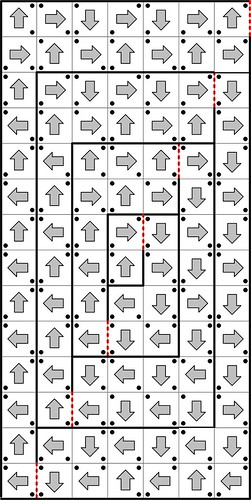
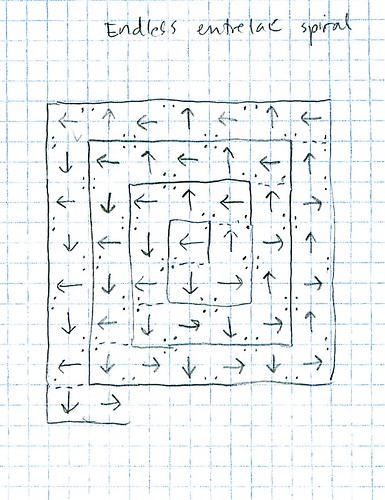
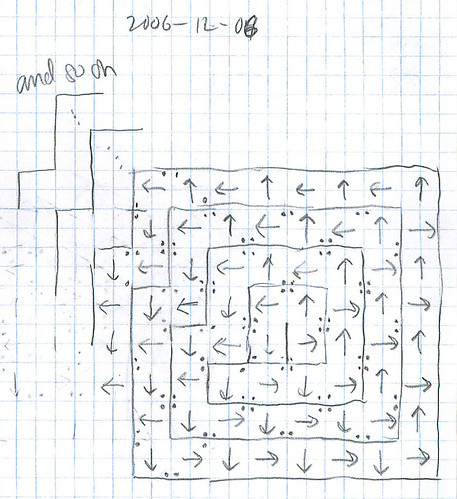
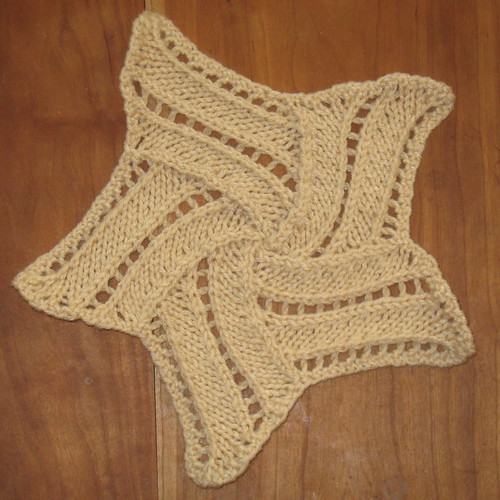
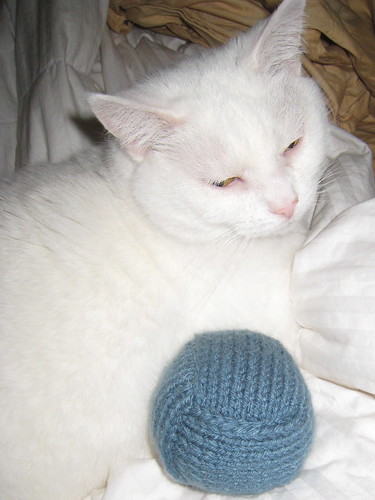

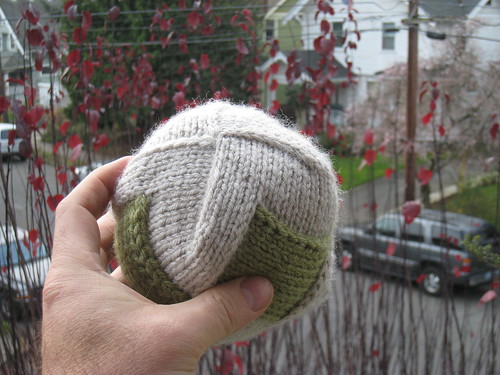

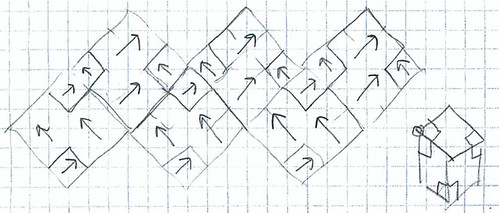
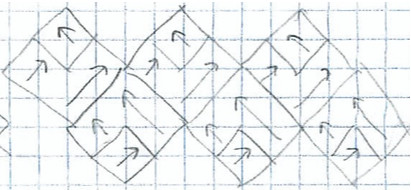
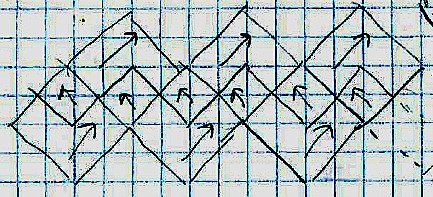
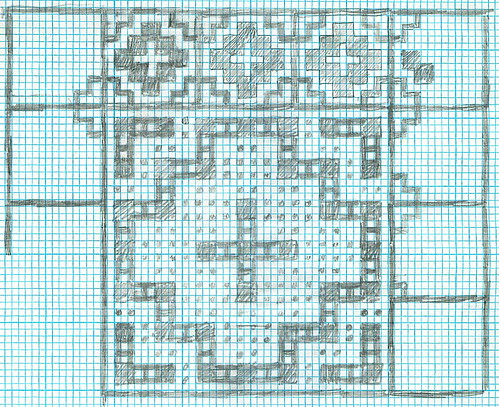



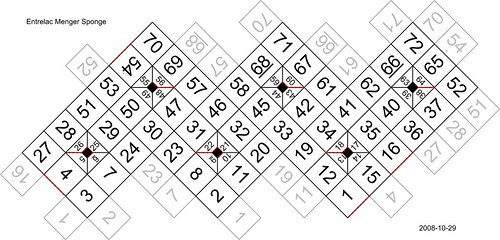
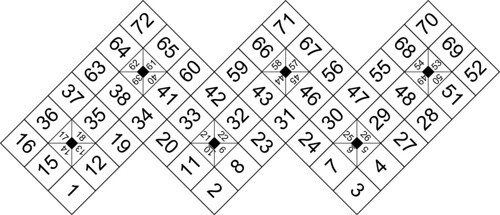
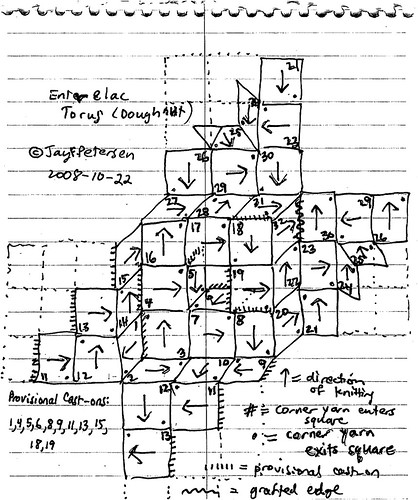
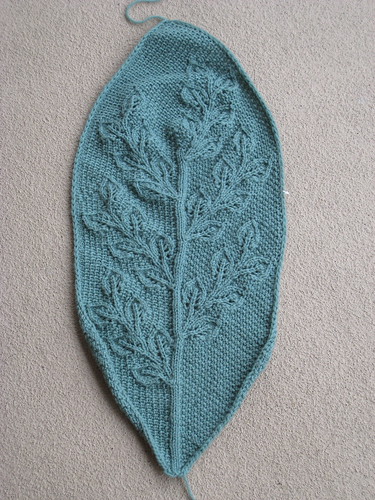







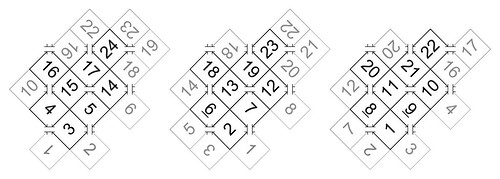

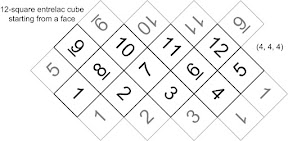

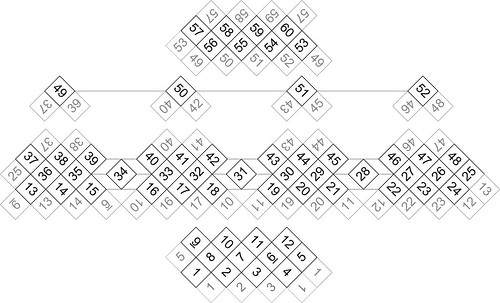
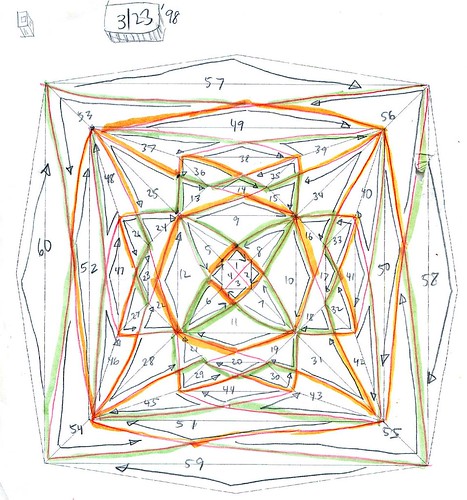
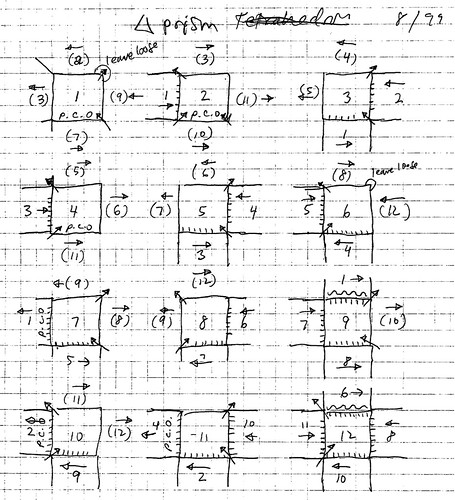
![Reblog this post [with Zemanta]](http://img.zemanta.com/reblog_e.png?x-id=efd23a35-14e9-4b05-9555-d5ad22f2b59e)